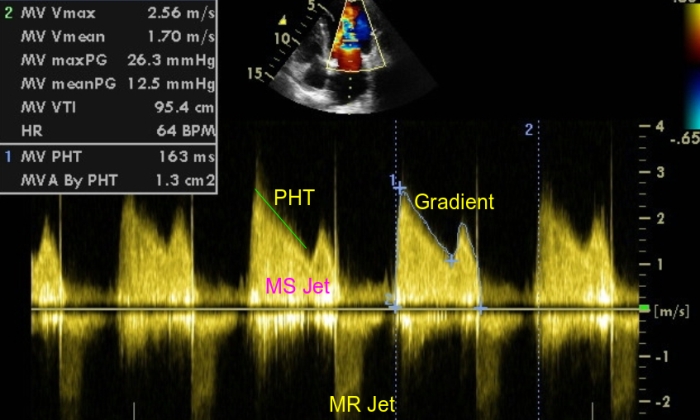Mitral valve area by pressure half time
Mitral valve area by pressure half time
Measurement of mitral valve area by pressure half time is an often applied method using Doppler echocardiography.

Mitral valve area can be calculated from the pressure half time (PHT) of the initial downward slope of the mitral A wave, which fuses with the E wave in mitral stenosis. Lower the slope, lower the mitral valve area and higher the severity of mitral stenosis. Pressure half time is the time taken for the gradient to reduce to half of its peak value. PHT 220 ms corresponds to a mitral valve area of 1 square centimeter. Here the PHT is 163 ms, hence mitral valve area will be higher (machine calculated value displayed as 1.3 square centimeters).
Mitral valve area by pressure half time: 220/PHT
Mitral valve area calculated by PHT has its own limitations, especially in the immediate post balloon valvotomy situation where there is an abrupt hemodynamic change [1]. Error increases if there is significant mitral regurgitation [2].
How was the pressure half time formula derived?
The value 220 in the pressure half time formula shown above is an empirical constant derived by Hatle J et al [3]. The relation between mitral valve area and fall in left atrial pressure when the mitral valve opens was noted as early as 1957 by Morrow AG et al during cardiac catheterization studies [4]. Libanoff AJ et al later used the pressure half time derived by cardiac catheterization to estimate mitral valve area [5]. In 1979, Hatle J et al described the Doppler assessment of pressure half time [6]. They later derived the empirical formula mentioned above.
Thomas JD et al gave a method of derivation of the pressure half time formula using a highly simplified model of the left atrium as a box with a side hole in which water was filled to a height and released by opening the orifice [7]. They showed by a complex mathematical calculation that pressure half time should vary inversely with mitral valve area. Their model also suggested that pressure half time would vary proportionately to net left atrial and ventricular compliance and to the square root of peak transmitral gradient. But this complex relation was masked in clinical situation as pressure and compliance would vary in opposite directions. They noted that in settings like balloon mitral valvotomy, left ventricular hypertrophy and aortic regurgitation, this relation between pressure half time and valve area would be altered. This explained why our study [1] also showed that pressure half time method was not very reliable in the post balloon mitral valvotomy period where the changes in initial pressure and compliance may be large.
References
- Sunil Roy TN, Krishnan MN, Koshy C, Sajeev CG, Francis J, Velayudhan CC, Venugopal K. Comparison of proximal isovelocity surface area method and pressure half time method for evaluation of mitral valve area in patients undergoing balloon mitral valvotomy. Echocardiography. 2005 Oct;22(9):707-12. doi: 10.1111/j.1540-8175.2005.00082.x. PMID: 16194163.
- Wisenbaugh T, Berk M, Essop R, Middlemost S, Sareli P. Effect of mitral regurgitation and volume loading on pressure half-time before and after balloon valvotomy in mitral stenosis. Am J Cardiol. 1991 Jan 15;67(2):162-8.
- Hatle J, Angelsen B. Doppler Ultrasound in Cardiology: Physical Principles and Clinical Applications. Philadelphia: Lea & Febiger. 1982:83.
- Morrow AG, Braunwald E, Haller VA, Sharp EH- Left atrial pressure pulse in mitral valve disease. Circulation 1957;16:399-405.
- Libanoff AJ, Rodbard S. Atrioventricular pressure half-time: measure of mitral valve area. Circulation 1968;38:144-50.
- Hatle L, Angelsen B. Tromsdal A. Noninvasive assessment of atrioventricular pressure half-time by Doppler ultrasound, Circulation 1979;60:1096-104.
- Thomas JD, Weyman AE. Doppler mitral pressure half-time: a clinical tool in search of theoretical justification. J Am Coll Cardiol. 1987 Oct;10(4):923-9. doi: 10.1016/s0735-1097(87)80290-5. PMID: 3309007.